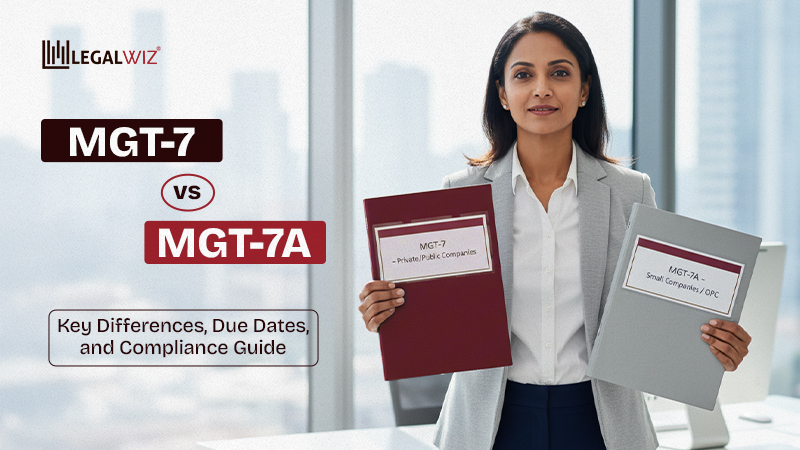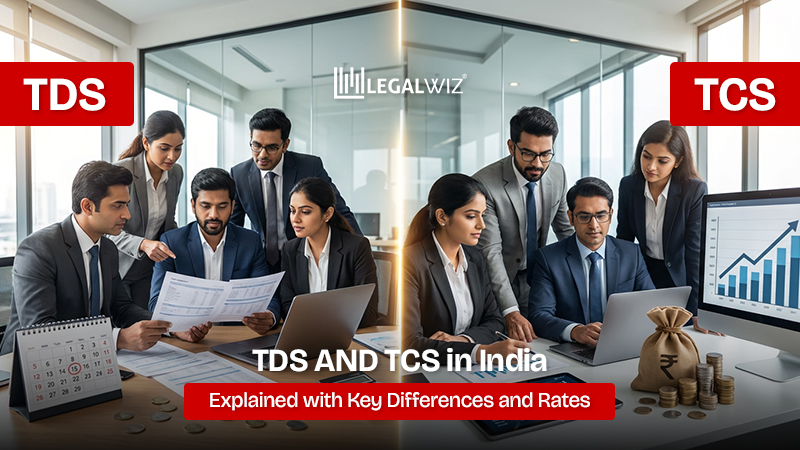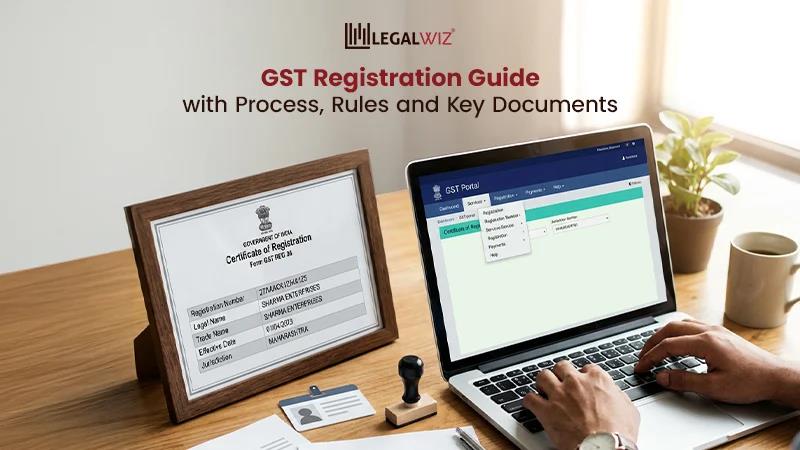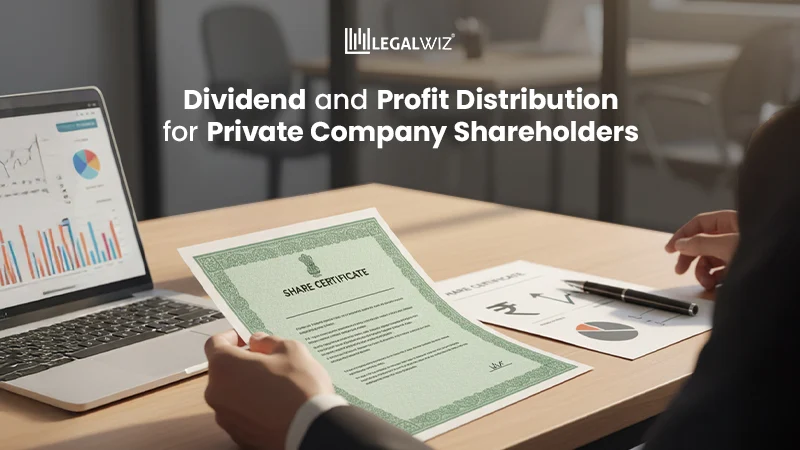MGT-7 vs MGT-7A: Key Differences, Due Dates, and Compliance Guide
Every company, whether public, private, or OPC, registered under the Companies Act, 2013 or earlier Acts, must file annual returns for a company with the MCA. This includes all companies that have ever formally registered with the government under the Companies Act, 2013 or any prior Act. This input determines the accuracy and timeliness of public documents, which explain a company’s ownership structure, management, and financials.
The MCA has created two separate versions, the MGT-7 and the MGT-7A, to make this procedure easier. Though they cater to different types of companies, their shared goal is the publication of annual reports. Corporations and other large organizations should use Form MGT-7, while OPC, single proprietorships, and smaller firms should use Form MGT-7A.
To properly file your yearly return, you must first ascertain which form is appropriate for your business. In this article, we will compare and contrast MGT-7 and MGT-7A, two forms of MGT, and look at the main differences between the two in terms of things like permitted users, due dates, and filing requirements.
| Important Announcement: The Ministry of Corporate Affairs (MCA) has extended the due date for filing MGT-7 and MGT-7A for FY 2024–25 until 31st December 2025. Companies can now complete their filings without paying any additional fees. This relief comes as part of the MCA’s recent update to the new V3 e-Forms system. |
1. What Are Forms MGT-7 and MGT-7A?
The MCA has developed two electronic yearly return forms, Forms MGT-7 and MGT-7A, in compliance with the Companies Act, 2013. These forms gather key information on ownership, management, and compliance for the fiscal year. While both forms serve the same purpose, the applicable form depends on the company’s size and classification.
(a) Form MGT-7
Form MGT-7 is the standard annual return form used by most registered companies (Except OPCs and small companies) under the Companies Act, 2013. It is designed to provide complete details of the company’s management and ownership structure during the financial year.
It typically covers details such as:
- Registered office and principal business activities
- Shareholding pattern and share transfers
- Details of directors, key managerial personnel (KMP), and meetings
- Indebtedness of the company
- Debentures, securities, and members
- Certification by a practicing professional (for applicable companies)
(b) Form MGT-7A
The Ministry of Corporate Affairs (MCA) made Form MGT-7A available on March 5, 2021, under GSR 159(E). This was part of the Companies (Management and Administration) Amendment Rules, 2021. This change made Form MGT-7A official. It is a shorter, easier-to-understand version of MGT-7 that was made to make it easier to follow.
This form is applicable only to:
- One Person Companies (OPCs)
- Small companies as per the Companies Act criteria
MGT-7A requires fewer disclosures and a simpler reporting structure, which makes it easier and quicker for these types of businesses to file their annual returns.
| If you are new to MCA compliance or are not sure how to do it online, filing Form MGT-7 might be hard. We’ve made a step-by-step guide to filing Form MGT-7 that breaks down each step, from getting the documents ready to submitting them on the site. This will help you do it correctly the first time. |
2. Key Differences Between MGT-7 and MGT-7A
MGT-7 and MGT-7A are annual return forms submitted under Section 92 of the Companies Act, 2013, however they vary in application, disclosure, certification, and compliance effort.
Learn the fundamental differences between the two formats.
1. MGT-7 and MGT-7A Applicability
- MGT-7 must be filed by all companies, except small companies and OPCs.
This includes:
- Public limited companies (listed and unlisted)
- Private limited companies that don’t qualify as “small”
- Section 8 (non-profit) companies
- Holding and subsidiary companies
- MGT-7A, on the other hand, is meant only for:
- Small Companies, and
- One Person Companies (OPCs)
This distinction ensures that smaller entities follow a lighter compliance process, while larger companies provide more detailed reporting.
2. Purpose of the Form MGT-7 & MGT-7A
- MGT-7 is meant to provide a full picture of a company’s structure, activities, and compliance status. It’s best for organizations that are of more public or regulatory interest.
- MGT-7A is a simpler version that makes it easier for smaller businesses to report by simply asking for the most important information.
3. Level of Disclosure for MGT-7 and MGT-7A
- MGT-7 requires extensive disclosures, such as:
- Basic company details – name, address, CIN, email, and website
- Nature of business – registered and main activities
- Share capital – authorised, issued, subscribed, and paid-up
- Details of promoters, directors, and KMP – names, DINs, and addresses
- Board and general meetings – records and attendance
- Remuneration of directors and KMP
- Penalties, fines, or prosecutions, if any
- Count of shareholders, debenture holders, and other security holders
- Information about branch offices, both in India and abroad
- Particulars of subsidiaries, holdings, and associate companies, including financial data
- Loans, guarantees, and securities given or received by the company
- Details of related party transactions
- Corporate Social Responsibility (CSR) activities and expenditure made during the year
- Compliance declarations as per the Companies Act, 2013
- Summary of loans, debentures, and total indebtedness
- Shareholding breakup – promoters, public, and institutional investors
- Other disclosures – director changes, remuneration, meetings, turnover, net worth, and FII holdings
- MGT-7A requires only limited disclosures, including:
- Basic company details – name, address, CIN, email, and website
- List of shareholders and debenture holders
- Details of directors and key management personnel
- Shareholding pattern with any changes from the previous year
- Information on principal business activities and associate companies
- Details of board and member meetings, along with directors’ remuneration (if applicable)
- Disclosure of any penalties or punishments imposed
- Simpler certification process, MGT-8 or external CS verification isn’t required. However, if a small company or OPC has a company secretary, they can still digitally sign the form
- Limited financial information and fewer reporting requirements compared to Form MGT-7
This makes MGT-7A more concise and easier to file.
This disclosure promotes openness and regulatory compliance. The MCA site displays the annual return, which must be submitted with the ROC within 60 days after the AGM.
4. Documents Required for MGT-7 and MGT-7A
- MGT-7 should attach multiple documents, such as:
- List of shareholders and debenture holders
- Meeting details and resolutions
- MGT-8 (if applicable)
- Penalty or compounding order details
- MGT-7A requires only essential attachments, like basic declarations or supporting details.
5. Certification Requirement
- Form MGT-8: A Practicing Company Secretary (PCS) only has to sign Form MGT-7 if the company meets specific financial requirements.
Rule 11(2) of the Companies (Management and Administration) Rules, 2014 says that a firm must have a PCS check Form MGT-8 if it goes over any of the following limits:
- Paid-up share capital is 10 crore rupees or more, or
- Turnover is 50 crore rupees or more
- MGT-7A generally does not require PCS certification, which lowers the cost and effort of compliance for smaller companies.
6. Filing Complexity
- MGT-7 involves more data fields, validations, and attachments, making the filing process time-consuming and detailed.
- MGT-7A is simpler and shorter, with minimal steps and fewer chances of error.
7. Compliance Cost
- MGT-7 typically incurs higher professional costs, as most companies engage professionals to review and certify the return.
- MGT-7A is cost-effective, as it can often be managed internally without extensive professional involvement.
8. Digital Signature Requirement
- MGT-7 must be signed by a Director and a Company Secretary (if appointed).
- MGT-7A requires only the Director’s Digital Signature Certificate (DSC) for submission.
9. Time and Effort Involved
- MGT-7 takes longer to prepare and verify, as more information and validation are needed.
- MGT-7A can be completed quickly, with minimal documentation and review.
In Summary
- Form MGT-7 → For larger or more regulated companies that require detailed disclosure.
- Form MGT-7A → For small companies and OPCs that need a simplified annual return process.
Both forms serve the same purpose, maintaining transparency and compliance, but differ in their depth, effort, and cost.
3. Due Dates for Filing MGT-7 and MGT-7A
Form MGT-7 is for regular companies, while Form MGT-7A is for OPCs and small companies. Both forms must be filed within 60 days of the AGM as required under the Companies Act, 2013.
- For companies that hold an AGM, the Due date = AGM date + 60 days
- The legal due date for an AGM is 60 days from the date when the AGM would have taken place. OPCs don’t have to have an AGM
Due Date of MGT7 & 7A (For FY 2024–25)
| Scenario | AGM Date/Applicable Date | Last Date to File MGT-7/MGT-7A |
| Company (AGM conducted) | AGM held on 30 September 2025 | 31st December 2025 (60 days from AGM) |
| OPC (no AGM) | AGM would have been due on 30 September 2025 | 31st December 2025 (60 days from deemed AGM date) |
(Note: The usual due date is 29th November, but the MCA has extended it to 31st December this year.)
Quick Notes:
- AGM must be held within 6 months of the financial year end (by 30 September if FY ends on 31 March)
- If ROC extends or delays the AGM, the 60-day filing period starts from the actual AGM date
4. Late Filing and Penalties for MGT-7 and MGT-7A
Section 403 of the Companies Act, 2013 says that if you submit Form MGT-7 or MGT-7A beyond the deadline, you will have to pay a fee.
How Late Fees Work
- You will have to pay a fine of ₹100 per day from the day after the due date till the day you file
- Every day, the late fee goes raised until the documentation is turned in properly
- There is no maximum limit on the overall penalty amount, so the longer you wait, the worse the punishment will be
For instance, if a business waits 30 days to file, it has to pay an extra ₹3,000 (₹100 × 30 days).
Why Timely Filing Matters
If you file late, you might get a fine, and MCA records could show that your business is “non-compliant.”
- Issues with approvals or files in the future
- Possible legal action for delays that recur again and again
Tip: Always submit your annual return far before the deadline to be in compliance and avoid additional fees.
5. Importance of Annual Return Filing Compliance
It is not only a legal necessity to file the annual return (Form MGT-7 or MGT-7A) under the Companies Act, 2013; it is also a crucial part of operating a company.
What makes it important?
| Purpose | Why It Matters |
| Legal Requirement | Mandatory under Section 92 to ensure company compliance |
| Transparency | Keeps details like shareholding, management, and ownership updated in MCA records |
| Credibility | Reflects good governance and builds public trust |
| Penalty Protection | Prevents fines, legal action, and possible disqualification of directors for non-compliance |
In short, regular and timely filing helps your company stay legally compliant, transparent, and trusted.
Conclusion: Build Trust Through Consistent Compliance
For every company, filing the annual compliance is more than a legal task; it reflects your company’s integrity and commitment to good governance. Staying compliant under the Companies Act, 2013, protects your business, reassures investors, and strengthens your public credibility.
Using the correct form, MGT-7 for regular businesses and MGT-7A for OPCs and small businesses, indicates that you are responsible and pay attention to the little things.
Doing compliance the proper way will help your brand in the long run. With LegalWiz, you can file your yearly taxes correctly, stay transparent, and earn your customers’ trust over time.
Frequently Asked Questions
What makes Form MGT-7 and Form MGT-7A different from each other?
Form MGT-7 is for all kinds of businesses, including public limited, private limited, and Section 8 companies. Form MGT-7A is a simplified form that One Person Companies (OPCs) and small enterprises use to make their compliance work easier.
Who has to fill out Form MGT-7A?
According to the Companies Act of 2013, only OPCs and small firms need to submit Form MGT-7A. A firm is “small” if its paid-up share capital is less than ₹4 crore and its revenue is less than ₹40 crore.
When do you have to submit Form MGT-7 and MGT-7A?
You have 60 days following the company’s Annual General Meeting (AGM) to send in both forms. The deadline is 60 days after the AGM would have happened if an OPC doesn’t have one. This is usually September 30 of the following financial year.
Is certification by a Company Secretary (CS) required for both forms?
Certification in Form MGT-8 by a Practicing Company Secretary is mandatory only for companies filing MGT-7 that have a paid-up share capital of ₹10 crore or more or turnover of ₹50 crore or more. Form MGT-7A generally does not need such certification unless the company voluntarily appoints a CS to sign it digitally.
What happens if MGT-7 or MGT-7A is filed late?
If the filing is delayed, a penalty of ₹100 per day is charged from the due date until submission. There is no upper limit to this penalty. Continuous non-filing may also lead to the company being marked as non-compliant on MCA records.

Sapna Mane
Sapna Mane is a skilled content writer at LegalWiz.in with years of cross-industry experience and a flair for turning legal, tax, and compliance chaos into clear, scroll-stopping content. She makes sense of India’s ever-changing rules—so you don’t have to Google everything twice.







